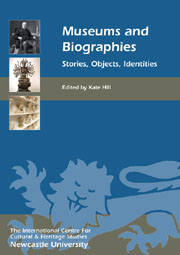Book contents
- Frontmatter
- Contents
- List of Illustrations
- Introduction: Museums and Biographies – Telling Stories about People, Things and Relationships
- INDIVIDUAL BIOGRAPHY AND MUSEUM HISTORY
- PROBLEMATISING INDIVIDUALS' BIOGRAPHIES
- INSTITUTIONAL BIOGRAPHIES
- OBJECT BIOGRAPHIES
- MUSEUMS AS BIOGRAPHY
- MUSEUMS AS AUTOBIOGRAPHY
- Endpiece: The Homunculus and the Pantograph, or Narcissus at the Met
- List of Contributors
- Index
Endpiece: The Homunculus and the Pantograph, or Narcissus at the Met
Published online by Cambridge University Press: 05 February 2013
- Frontmatter
- Contents
- List of Illustrations
- Introduction: Museums and Biographies – Telling Stories about People, Things and Relationships
- INDIVIDUAL BIOGRAPHY AND MUSEUM HISTORY
- PROBLEMATISING INDIVIDUALS' BIOGRAPHIES
- INSTITUTIONAL BIOGRAPHIES
- OBJECT BIOGRAPHIES
- MUSEUMS AS BIOGRAPHY
- MUSEUMS AS AUTOBIOGRAPHY
- Endpiece: The Homunculus and the Pantograph, or Narcissus at the Met
- List of Contributors
- Index
Summary
… ideology, roughly speaking, is about what we think we see when we aren't really looking (Bhaba 1998, 48)
Magnificat anima mea Dominum (Luke 1:46)A clear awareness of the reality of our own finitude being a possibly unbearable source of anxiety, we may at times be tempted to actually believe in our own immortality. Autobiographic, biographic and museographic possibilities for after-lives seduce us into imagining the constraints of the real being eliminated if we keep a tense yet measured distance – a coy similitude or a pantographic relationship – toward our (self) image. As epistemological technologies of virtual space, museums and collections keep the real at a manageable distance in the face of anxieties. The ego's habitation in museological space opened up by its mirror image, however, is yet more complicated and tense. On the one hand, the duplication of the self and the distance it presupposes is a necessary condition for reflection and autonomy. Yet on the other hand, the ego, driven by the will to converge with its image, might be tempted (like the ancient patron saint/avatar of the museum-goer, Narcissus) to annihilate that distance. Hence the efficacy of socio-aesthetic institutions such as museums and religions depends on the maintenance of that tension; the maintenance of a consciousness of the artifice of our realities as artifice – even as we masquerade its denial.
- Type
- Chapter
- Information
- Museums and BiographiesStories, Objects, Identities, pp. 321 - 326Publisher: Boydell & BrewerPrint publication year: 2012



